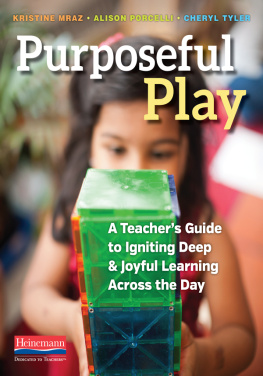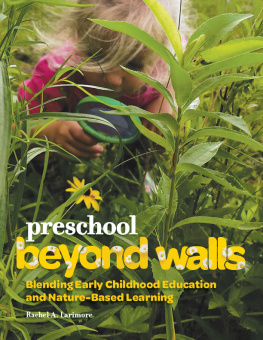Published by Redleaf Press
10 Yorkton Court
St. Paul, MN 55117
www.redleafpress.org
2013 by Gaye Gronlund
All rights reserved. Unless otherwise noted on a specific page, no portion of this publication may be reproduced or transmitted in any form or by any means, electronic or mechanical, including photocopying, recording, or capturing on any information storage and retrieval system, without permission in writing from the publisher, except by a reviewer, who may quote brief passages in a critical article or review to be printed in a magazine or newspaper, or electronically transmitted on radio, television, or the Internet.
Portions of this book were first published in Focused Early Learning by Gaye Gronlund, 2003.
First edition 2013
Cover design by Jim Handrigan
Cover photograph Segrey Galushko/Veer
Interior design by Ryan Scheife, Mayfly Design
Typeset in Whitman
Photograph on page 168 by Kathy Stewart
Photograph on page 188 by MediaDesigns, Inc.
Photograph on page 214 by Gail Holtz
Excerpts on pages 5, 101, 117, 120121, 231, and 235 are from Developmentally Appropriate Practice in Early Childhood Programs Serving Children from Birth through Age 8, 3rd ed., edited by Carol Copple and Sue Bredekamp. Copyright 2009 National Association for the Education of Young Children (NAEYC). Reprinted with permission.
Excerpts on pages 27 and 30 are from Early Childhood Curriculum, Assessment, and Program Evaluation: Building an Effective, Accountable System in Programs for Children Birth through Age 8, a position statement from NAEYC and NAECS/SDE (National Association for the Education of Young Children and National Association of Early Childhood Specialists in State Departments of Education). www.naeyc.org/files/naeyc/file/positions/CAPEexpand.pdf. Copyright 2003 NAEYC and NAECS/SDE. Reprinted with permission.
Excerpt on page 156 is from Learn to Say Yes! When You Want to Say No! to Create Cooperation instead of Resistance, Young Children 66 (4): 4044, by Katharine Kersey and Marie Masterson. Copyright 2011 NAEYC. Reprinted with permission.
Excerpts on page 157 are from Developing Young Childrens Self-Regulation through Everyday Experiences, Young Children 66 (4): 4651, by Ida Rose Florez. Copyright 2011 NAEYC. Reprinted with permission.
Excerpt on page 197 is from Developmentally Appropriate Practice in Early Childhood Programs Serving Children from Birth through Age 8, a position statement by NAEYC. Copyright 2009 NAEYC. www.naeyc.org/files/naeyc/file/positions/PSDAP.pdf. Reprinted with permission.
Library of Congress Cataloging-in-Publication Data
Gronlund, Gaye, 1952
Planning for play, observation, and learning in preschool and kindergarten / Gaye Gronlund.
p. cm.
Includes bibliographical references and index.
ISBN 978-1-60554-250-8 (e-book)
1. Play. 2. Education, PreschoolCurricula. 3. KindergartenCurricula. 4. Curriculum planning. I. Title.
LB1140.35.P55G76 2012
372.21dc23
2012032226
To my children, Colin and Gwen, two wonderful adults now, but as children,
two imaginative and wonderfully creative players, Mr. Earl and Melody Legs!
Contents
Heartfelt thanks to
the New Mexico PreK Leadership and Consultants, who have continually refined my writings and put them into action, working toward high-quality preschool experiences for the four-year-olds of New Mexico
my friend and colleague, Marlyn James, who supports and challenges my thinking and practice
the early childhood practitioners who contributed their thoughts to this manuscript
my editor, Jeanne Engelmann, whose help is invaluable
I have been in the field of early childhood education for thirty-six years. I have taught in a variety of early childhood settings: a cooperative nursery school, a university laboratory school, a Head Start program, special education preschool classrooms, and a public school kindergarten. As a consultant and an author, I have had the privilege of working with thousands of teachers around the country, helping them identify the best ways to implement recommended curricular and assessment strategies and meet the needs of the children in their unique settings.
Over the years, I have seen the expectations for preschool and kindergarten change dramatically. No longer is it enough to provide a fun, engaging social experience for young children. Teachers are held accountable for helping children achieve preschool and kindergarten standards that define expected performancenot only in the social domain but in other domains as well. And those domains are more traditionally academic in natureliteracy, mathematics, science, and social studies. It is not enough for early childhood educators to love and enjoy young children. They must also know their states standards, plan curriculum incorporating those expectations, and conduct assessments that help them meet each childs needs. Academic learning is the focus now, and assessment of each childs learning is necessary.
I think this shift in early childhood education is wonderful! I also think it is challenging.
As I work with preschool and kindergarten teachers across the country, I hear their confusion and frustration about the challenging aspects of this shift. They feel they must push back against pressures for inappropriate early educational experiences for young children. They ask questions such as:
How do I do implement developmentally appropriate practices when others demand more accountability?
How do I plan for play experiences, give children choices, and not have absolute chaos?
How do I focus on learning and standards and still nurture the joy of learning?
Is it okay to plan teacher-directed activities? How much of my day should be devoted to group times and how much to play?
How do I implement assessments that really show what the children are learning and how they are applying their skills?
And the question I hear most frequently is
How do I write a lesson plan that shows everything I do that is intentional and preplanned and is also child focused and responsive, integrating all of what I know are best practices?
This book is my attempt to answer these questions.
The Wonders of Teaching Young Children
As I said earlier, I think there are wonderful parts to this shift in early education. Lets consider those wonderful parts. The development of early learning standards for preschool and kindergarten has occurred in all fifty states in America, and many states have developed or are developing standards or guidelines for infant/toddler development. The beauty of early learning standards is that they define reasonable expectations for young children at different age levels. Professionals in the field of early education have written most of these standards, and most are helpful in outlining what young children can do. No longer do teachers have to rely on sources such as developmental checklists and other information to piece together their knowledge base of child development. Early learning standards now serve as the reference point for planning curriculum and assessing young childrens progress. Teachers have a common language grounded in research and endorsed by their state. This gives them a strong foundation from which to teach. Thats good!






